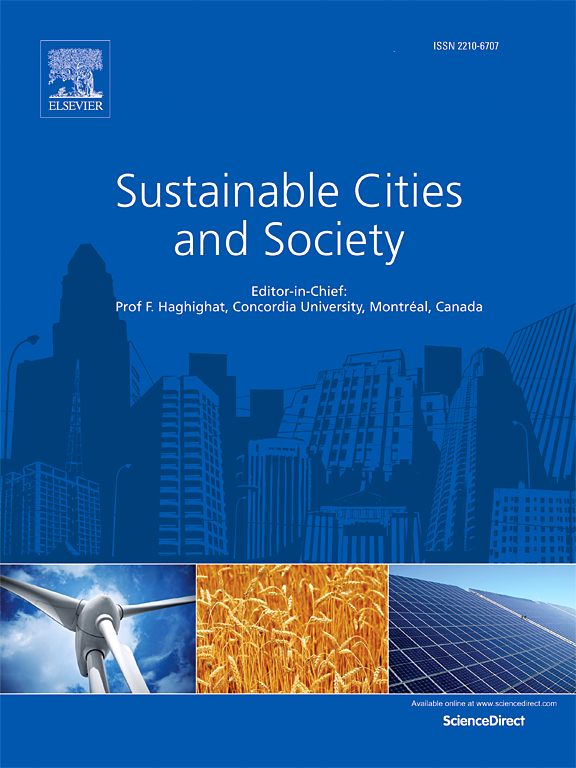How are green spaces associated with chronic disease incidence in Australia? Direct health benefits and interactive effects with socioeconomic status based on multiple green space indicators
IF 10.5
1区 工程技术
Q1 CONSTRUCTION & BUILDING TECHNOLOGY
引用次数: 0
Abstract
The health benefits of urban greenery are well-documented, yet findings vary depending on the green space indicators used. Given the limited Australia-based research incorporating both traditional and emerging indicators, this study employs the proportion of parkland, the Normalized Difference Vegetation Index (NDVI), and Google Street View Greenness (SVG), to explore how green spaces and their interactions with socioeconomic status relate to chronic disease incidence rates in Sydney at Statistical Area Levels 1 and 2 (SA1 and SA2). The findings indicate that: (1) While green spaces are not significantly related to overall chronic diseases, they show strong associations with specific diseases, particularly dementia (SA1: Park: coef. = -0.004, p < 0.001; NDVI: coef. = -0.008, p < 0.001; SVG: coef. = -0.009, p < 0.001; SA2: SVG: coef. = -0.005, p < 0.05) and diabetes (SA1: SVG: coef. = -0.013, p < 0.001; SA2: Park: coef. = -0.009, p < 0.05; NDVI: coef. = -0.016, p < 0.01; SVG: coef. = -0.033, p < 0.001), with SVG being the most prevalent predictor. (2) Green spaces, particularly parkland, may mitigate chronic disease risks in lower socioeconomic regions, especially in aging areas (SA1: age#Park: coef. = -0.125, p < 0.001; age#NDVI: coef. = -0.081, p < 0.01; age#SVG: coef. = -0.078, p < 0.01). Additionally, these associations are more pronounced at the neighborhood scale than at the suburb scale. This study examines multiple green space indicators from an Australian perspective, offering insights for international comparisons and public health improvements.

求助全文
约1分钟内获得全文
求助全文
来源期刊

Sustainable Cities and Society
Social Sciences-Geography, Planning and Development
CiteScore
22.00
自引率
13.70%
发文量
810
审稿时长
27 days
期刊介绍:
Sustainable Cities and Society (SCS) is an international journal that focuses on fundamental and applied research to promote environmentally sustainable and socially resilient cities. The journal welcomes cross-cutting, multi-disciplinary research in various areas, including:
1. Smart cities and resilient environments;
2. Alternative/clean energy sources, energy distribution, distributed energy generation, and energy demand reduction/management;
3. Monitoring and improving air quality in built environment and cities (e.g., healthy built environment and air quality management);
4. Energy efficient, low/zero carbon, and green buildings/communities;
5. Climate change mitigation and adaptation in urban environments;
6. Green infrastructure and BMPs;
7. Environmental Footprint accounting and management;
8. Urban agriculture and forestry;
9. ICT, smart grid and intelligent infrastructure;
10. Urban design/planning, regulations, legislation, certification, economics, and policy;
11. Social aspects, impacts and resiliency of cities;
12. Behavior monitoring, analysis and change within urban communities;
13. Health monitoring and improvement;
14. Nexus issues related to sustainable cities and societies;
15. Smart city governance;
16. Decision Support Systems for trade-off and uncertainty analysis for improved management of cities and society;
17. Big data, machine learning, and artificial intelligence applications and case studies;
18. Critical infrastructure protection, including security, privacy, forensics, and reliability issues of cyber-physical systems.
19. Water footprint reduction and urban water distribution, harvesting, treatment, reuse and management;
20. Waste reduction and recycling;
21. Wastewater collection, treatment and recycling;
22. Smart, clean and healthy transportation systems and infrastructure;
 求助内容:
求助内容: 应助结果提醒方式:
应助结果提醒方式:


